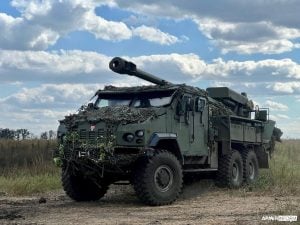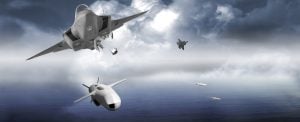COAS visits forward areas in Western Command
- General MM Naravane COAS visited forward areas in Western Command and reviewed the operational preparedness.
- COAS commended the troops for their high morale and exhorted them to work with same zeal and enthusiasm.
Higher Defence Management Course started at CDM
- Higher Defence Management Course commenced on 13th July at College of Defence Management.
- Lt Gen Raj Shukla, Army Cdr, ARTRAC delivered inaugural address & exhorted tri-services officers to keep up the spirit of jointmanship.
- He also addressed course on “Challenges before Indian Statecraft”.
Development of P7 Heavy Drop System
- DRDO has developed P7 Heavy Drop System which is capable of para dropping military stores up to 7-ton weight class from IL 76 aircraft. This system is fully indigenous & being manufactured by L&T who makes the platform system, parachutes manufactured by Ordnance Factory.
- Meanwhile, Lt Gen Vinod Bhatia, former Director Para SF, claims that the GSQR was prepared by him in 1998/99. He tweeted “Heavy drop platform developed now after 22 years, when IL 76 are in the last leg, we have C130J Hercules and C5 aircraft with heavy drop equipment. What a waste of time, talent and money. Happy Landings paratroopers.”
Boeing to build new F-15EX fighter jets for U.S. Air Force
- U.S. aerospace giant Boeing Company received a $1.2 billion contract July to begin buying the first eight F-15EX fighter jets.
- The contract, awarded to Boeing, provides for the design, development, integration, manufacturing, test, verification, certification, delivery, sustainment, and modification of F-15EX aircraft, including spares, support equipment, training materials, technical data, and technical support.
- Interestingly, F-15EX will replace the oldest United States Air Force’s F-15C/Ds in the service’s inventory. Eight F-15EX aircraft were approved in the fiscal year 2020 budget and 12 were requested in the FY21 budget. The Air Force plans to purchase a total of 76 F-15EX aircraft over the five-year Future Years Defense Program.
- Work will be performed in St. Louis, Missouri; and at Eglin Air Force Base, Florida, and is expected to be completed Dec. 31, 2023, according to a press release issued Monday by U.S. Department of Defense.
- The F-15EX is a two-seat fighter with U.S.-only capabilities. It features a deep magazine that can carry a load of advanced weapons. The platform also requires minimal transitional training or additional manpower and little to no infrastructure changes, ensuring the continuation of the mission.
- The most significant difference between the F-15EX and legacy F-15s lies in its Open Mission Systems (OMS) architecture. The OMS architecture will enable the rapid insertion of the latest aircraft technologies. The F-15EX will also have fly-by-wire flight controls, a new electronic warfare system, advanced cockpit systems, and the latest mission systems and software capabilities available for legacy F-15s.
- The first eight F-15EX aircraft will be fielded at Eglin Air Force Base, Florida, to support testing efforts. The delivery of the first two aircraft is scheduled for the second quarter of FY21. The remaining six aircraft are scheduled to deliver in FY23. The Air Force is using the Strategic Basing Process to determine the fielding locations for subsequent aircraft lots.
NATO Forces return to Black Sea for the second time this year
- NATO Maritime Command has announced that standing NATO Maritime Group Two (SNMG2) and Standing NATO Mine Countermeasures Group Two (SNMCMG2) units have entered the Black Sea for the second time this year to conduct further routine operations, and to participate in two regional exercises organised by the Bulgarian and Ukrainian navies.
- SNMG2 arrived to the Black Sea on 9 July, and is composed of three frigates from Spain, Romania and Turkey, led by Rear Admiral Manuel Aguirre of the Spanish Navy, with the Spanish frigate Álvaro de Bazán (F-101) as the flagship.
- SNMCMG2 vessels HS Aliakmon (flagship), ESPS Tambre, TCG Amasra and ITS Gaeta, led by Commander Dimitrios Katsouras of the Hellenic Navy, entered the Black Sea on 7 July, where it was joined by ROS Lupu Dinescu and sailed towards Burgas (BUL) where they arrived on 10 July.
- With three Allied nations, Bulgaria, Romania and Turkey, and two regional partners, Ukraine and Georgia bordering the Black Sea, Standing Naval Group presence in the region is a regular occurrence. Apart from conducting maritime security patrols in international waters, the two exercises will help enhance interoperability between Allies and regional partners.
- With visits planned to Bulgaria and Ukraine in the coming days, all activities of the Standing NATO Forces ashore will continue to abide by COVID-19 restrictions, designed to protect their operational capabilities. However, as national regulations are eased, opportunities for key engagements will help reaffirm and build these regional relationships.
- SNMG2 and SNMCMG2 are two of our four standing forces that comprise the maritime component of the Very High Readiness Joint Task Force (VJTF), which is part of the NATO Response Force (NRF). To respond to contingency situations additional forces can be added to these groups, with the NATO command staff onboard and the ships of the group as the nucleus, capable of providing timely support to NATO operations.
- NATO warships also will take part in Sea Breeze is a U.S. and Ukraine co-hosted multinational maritime exercise that held in the Black Sea and is designed to enhance interoperability of participating nations and strengthen maritime security and peace within the region.
U.S. Army deploys approximately 60 helicopters to Germany, Poland, and Latvia
- The U.S. Army has announced that it is deploying approximately 60 military helicopters from La Rochelle, France, and fly to training locations in Germany, Poland and Latvia.
- The Baltic Security also reported that from July 13 to 20, about 10 U.S. Army UH-60 Black Hawk helicopters assigned to 101st Combat Aviation Brigade will arrive at Lielvārde Air Base, Latvia, for a nine-month rotation in support of Atlantic Resolve.
- During these dates, residents of Siauliai and neighboring communities may see a large formation of helicopters.
- “This flights are scheduled to occur between the hours of 6 a.m. and 6 p.m. No weekend flights are scheduled at this time,” the U.S. Army Europe said on Twitter.
- These flights will adhere to standard noise abatement procedures.
- Since April 2014, U.S. Army Europe has led the Department of Defense’s Atlantic Resolve land efforts by bringing units based in the U.S. to Europe for nine months at a time.
- Atlantic Resolve provides these rotational units with the ability to build readiness, increase interoperability and enhances the bond between ally and partner militaries through multinational training events. There are three types of Atlantic Resolve rotations – armoured, aviation and sustainment task force.
Russia develops new light air-transportable armoured vehicle
- Russia’s Military Industrial Company has unveiled the new state-of-the-art family of armoured vehicles can carry out a wide variety of missions, including reconnaissance, command and control, recovery and evacuation of wounded personnel.
- The Strela vehicle weighs just 4.7 tonnes, which allows quickly transporting it to another area or as part of tactical airborne assault forces by military transport helicopters like a Mi-8 on an external sling. The Strela is designated to transport personnel and various cargos, ensuring the required level of armoured protection.
- The vehicle’s armor provides the 2nd-degree ballistic protection (it shields against bullets with a heat-strengthened core of 5.45x39mm cartridges of the AK-74 assault rifle, bullets with the heat-strengthened core of 7.62x39mm rounds of the AKM submachine-gun and bullets with the non-heat strengthened core of 7.62x54mm ammunition fired from the Dragunov snipe rifle). The vehicle’s anti-blast protection shields the crew inside it upon hitting mines or explosives with a yield of up to 2 kilograms in TNT equivalent.
- The Strela can develop a speed of up to 155 km/h on the road and carry eight personnel. The vehicle’s design is based on advanced assemblies, units and accessories planned for their use in mass production in the domestic auto industry. The vehicle’s components are 100% produced on the territory of Russia.
Several Russian soldiers wounded in car bombing in Syria
- Several Russian soldiers were wounded Tuesday in a car bombing in northeastern Syria.
- Massive car bomb attack on Russian vehicles within a joint Turkish-Russian patrol on the M4 highway in Idlib, Syria.
- Russian Reconciliation Center for Syria announced Tuesday also said that three Russian servicemen sustained light injuries in an explosion in Syria’s Idlib during a joint patrol with Turkish counterparts.
- “On July 14, at about 8:50 Moscow time, an improvised explosive device detonated near the settlement of Erikha during a joint Russian-Turkish patrol of the M4 highway. Three Russian servicemen sustained light injuries,” the Center said, adding that there are injured among the Turkish crew as well.
- “All injured were promptly evacuated from the area. Russian servicemen were delivered to the Kmeimim base, where they received all necessary medical aid. Their lives are out of danger,” the announcement says.
- Following the incident, the joint patrolling was stopped, damaged vehicles are being evacuated.
- “The command of the Russian armed forces group in Syria, in cooperation with the Turkish military and the Syrian national security agencies, seeks to determine whether militants operating in the Idlib de-escalation area are involved in attack on the convoy,” the Center said.
- The M4 highway, also known as the Aleppo-Al Hasakah road, is about 30 kilometers (19 miles) from Turkey’s southern border.
- This March, Ankara and Moscow agreed on a protocol urging parties to “cease all military actions along the line of contact in the Idlib de-escalation area.”
- The protocol said joint Turkish-Russian patrols would begin on March 15 along the M4 highway from the settlement of Trumba – 2 km (1.2 miles) west of Saraqib – to the settlement of Ain al-Havr.
- Idlib has long been under siege by Assad regime forces and its allies, and previous cease-fires for the region were plagued by violations.
Nepal bought 6 Chinese planes that Dhaka rejected. Now it grounds them: Report
- Nepal Airlines has decided to ground six Chinese planes bought under a government-to-government pact from July 16, according to a report in The Kathmandu Post. The newspaper, which cited an order by the Nepal Airlines Corporation, said the airline board had cleared the move because it could not afford to fly the 17-seater Y12e and the 56-seater MA60 and wanted to cut its losses.
- Nepal had been nudging China to gift it planes but came around to buying the six planes after Beijing told the government that it would need to buy aircrafts from them before it could expect the gift. Kathmandu agreed to buy six and got two more as gifts.
- The first of two Chinese MA60 landed at Kathmandu’s Tribhuvan International Airport in 2014 while the first batch of four Y12e arrived in November 2014. As part of the deal, the Post reported, Nepal received one MA60 and Y12e respectively worth Rs 2.94 billion as a gift in 2014.
- The decision to ground the planes comes six years after the first batch landed in Kathmandu. It was the first acquisition by Nepal Airlines in 28 years.
- Achyut Pahari, a board member at Nepal Airlines, told the Post that the plane was not fit for Nepal but had been forced upon the airline in a government-to-government deal.
- The newspaper said when teams from Bangladesh and Nepal travelled to China to inspect the aircraft back in 2011, the team from Bangladesh rejected the aircraft. Kathmandu’s experts, however, recommended it.
- Pahari called the decision to buy the aircraft, Nepal’s “worst decision” and claimed the decision was prompted “by greed for commissions”.
- “Nepal Airlines is paying the price now. Flying these planes means throwing good money after bad,” Pahari said, according to the Post.
- An audit report last year said the Chinese planes had been incurring heavy losses to Nepal ever since they were first purchased.
- The decision to buy the planes, according to the report, was not the only flawed call by the airline. The airline has not been able to ensure that it has pilots trained to fly the Chinese aircraft.
- Sanjiv Gautam, former director general of the Civil Aviation Authority of Nepal, told the Post blamed the managerial problems for the problem. “In the last six years, it has not produced any captains, and those who were promoted to captain have been transferred to fly Airbus jets in the same company,” he told the Post.
Indian forces to acquire Heron drones, Spike anti-tank guided missiles from Israel
- Engaged in a boundary dispute with China in eastern Ladakh, India is planning to enhance its surveillance capabilities and firepower by placing orders for Heron surveillance drones and Spike anti-tank guided missiles from Israel under the emergency financial powers granted by the government.
- The Heron unmanned aerial vehicles are already in the Air Force, Navy, and the Army and are being used extensively at the moment by both Army surveillance and Target acquisition batteries and Air Force in the Ladakh sector.
- “There is a need for acquisition of Heron UAVs to add to the existing fleet of these drones for meeting the requirements of our Air Force fleet. We are planning to place orders for these UAVs,” government sources told without specifying the numbers to be procured.
- The Heron has been in service with the three defence wings for several years now and can fly continuously for more than two days at a stretch providing reconnaissance from an altitude of more than 10 kilometres.
- The forces are also working towards inducting an armed version of the UAV, as well as upgrading the existing fleet into combat UAVs under the ambitious ‘Project Cheetah’ spearheaded by the Indian Air Force.
- On the other hand, the Army is planning to place orders for more Spike anti-tank guided missiles which were received by it last year from Israel under the emergency financial powers granted to the services in the Post-Balakot air strikes scenario.
- Last time, the Army had gone in for 12 launchers and 200 Spike missiles.
- “We are planning to acquire more of these anti-tank missiles for tackling any threat from the enemy armoured regiments,” the sources said.
- In the meanwhile, DRDO is working towards developing the indigenous Man-Portable Anti-Tank Guided Missile (MP-ATGM) which will meet the bulk requirement of over 50,000 of these missiles needed by the Infantry units.
- The defence forces have also initiated requirements for acquiring Spice-2000 bombs, assault rifles, ammunition and missiles, and some platforms for meeting the requirements in case the situation escalates further on the Line of Actual Control.
India’s S-400 Missile System Could Detect Pakistan Air Force F-16s At Long Range
- Turkish Air Force F-16 and F-4 fighter jets carried out Low Level and High altitude flying to testing S-400 system back then to check if the missile system could be tracked and searched in long-range and both 91N6E surveillance and acquisition radar and the 96L6E air search and acquisition radar working in tandem was able to detect F-16s at long range with missile getting firing clearance soon.
- Turkey owned S-400 system manned by Mix Russian-Turkish Crew who have been trained for such scenarios and was joined by senior officials of the Turkish Air defense unit as observers were to demonstrate the capabilities of the S-400 Theater air defense system.
- Defense analysts believe that it was also done to see if Turkish jets can lure rival jets into the S-400 kill zone and also to see if Identification, friend or foe (IFF) system can differentiate between Two American jets with one playing the aggressor.
- This should ring alarm bells in the Islamabad which counts on it American build 70 odd F-16s to provide it air superiority against Indian Air Force in the region in case of full-fledged war takes place between both countries.
- The S-400 can engage targets at a distance of 400 km and an altitude of up to 30 km and can track an Aerial Tanker or AWACS size platforms at a range of 600km and fighter size targets at 400 km.
- Indian Defence analysts have been claiming that long-range Radars which comes with S-400 Theater air defense system will ensure that all PAF’s jets, once airborne from their respected air bases, will be picked up the radars of the S-400 due to close proximity of the all the forward airbases of the PAF in its Eastern sector and can S400 will be able to engage up to 36 targets at a time and simultaneously launch 72 missiles.
- The impact of the Indian S-400 on Pakistan may be viewed on three distinct stages: during peace, post incursion similar to the Balakot raid and when war is declared.
- Even during peace, Pakistan will have to deal with the fallout of the Indian S-400 induction. When operationally deployed to defend along with the French Rafale and the support elements of AEWCs, aerial refuellers and spoofers, aerial raids by the PAF on Indian targets by manned aircraft would become incredibly challenging and costly
- In the event of an all-out war between India and Pakistan, the S-400 system would limit the freedom of action of the PAF’s employment of it aerial platforms, particularly the enablers like the AEWC, spoofers, refuellers and transport fleet. Their employment would have to be judiciously planned to keep them out of the S-400 lethal ranges and yet be able to perform their operational tasks.
- An all-out war between nuclear-armed India and Pakistan is not likely but cannot be ruled out. In such a scenario, the Indian S-400 system, besides providing a strong defensive shield to the majority of the Indian Vulnerable Areas (VAs) and Vulnerable Points (VPs), can also shoot down PAF combat planes and support platforms well inside Pakistan.
- The freedom of operation for the PAF even inside its territory would be limited during the conflict. In addition, the S-400 employed judiciously along with the Indian AWAC platforms can target the PAF interceptors deployed to counter the IAF raids on its VAs and VPs. The PAF would have to come up with options to neutralize the threat to its air defence fighters.
Indian and Chinese commanders hold talks on further disengagement in Ladakh
- The fourth round of Lt General-level talks began around 11:30 AM yesterday at a designated meeting point in Chushul on the Indian side of the LAC, the de-facto border between the two countries.
- The Indian delegation is led by Lt Gen Harinder Singh, the commander of the Leh-based 14 Corps, while Major General Liu Lin, commander of the South Xinjiang military region, was scheduled to lead the Chinese side.
- The key focus of the high-level meeting is expected to be to a roll out of the phase two of the disengagement process including in Pangong Tso and Depsang, besides withdrawal of forces and weapons from the rear bases in a time-bound manner, the sources said.
- The Indian side is expected to insist on “total restoration” of status quo ante in all areas of eastern Ladakh prior to May 5 when the standoff began following a clash between the troops of the two countries in Pangong Tso, they said.
- The sources said the two sides are also expected to finalise a roadmap for overall restoration of peace and tranquillity in the high-altitude region that witnessed an eight-week bitter standoff between the troops of the two countries.
Keep HAL out of Naval helicopter plan, private companies tell government
- The private sector wants the Centre to bar Hindustan Aeronautics Ltd NSE -2.65 % (HAL) from a ₹21,000 crore plan to manufacture naval utility helicopters (NUH), saying that the state-owned company has an undue advantage as it has access to government-funded infrastructure and the ability to cross-subsidise the bid through other nominated orders.
- The companies were responding to a question posed by the defence ministry in May on allowing HAL in the competition, which was reserved for the private sector as reported by ET. They said the monopoly of the state-owned enterprise needs to be broken and a level playing field is needed for all bidders.
- Four Indian companies – Bharat Forge NSE -0.61 %, Tata Aerospace and Defence, Mahindra Defence Systems and Adani Defence – are contending for the Make in India programme to manufacture 111 naval utility helicopters under the strategic partnership (SP) model in collaboration with a foreign technology provider.
REVIEW QUESTIONS
- Higher Defence Management Course commenced on 13th July at:
- Military Institute of Law
- College of Defence Management
- Military College of Telecommunications Engineering
- College of Air Warfare
ANSWER: B
- F-15EX will replace which of these oldest United States Air Force’s aircraft in the service’s inventory?
- F-15C/Ds
- F-16C/Ds
- F-22C/Ds
- None of the Above
ANSWER: A
- The most significant difference between the F-15EX and legacy F-15s lies in its OMS Architecture. OMS means:
- Optical Mission Systems
- Open Mission Systems
- Obligated Mission Systems
- Oppressive Mission Systems
ANSWER: B
- Russia develops new light air-transportable armoured vehicle called as:
- Streta
- Strela
- Streeter
- Strateger
ANSWER: B
- DRDO is working towards developing the indigenous MP-ATGM which means:
- Mission Prominent Anti-Tank Guided Missile
- Mission Prominent Anti-Telecom Guided Missile
- Man-Portable Anti-Tank Guided Missile
- Man-Portable Anti-Telecom Guided Missile
ANSWER: C
- Which among the following is NOT a company contending for the Make in India programme to manufacture 111 naval utility helicopters under the strategic partnership (SP) model in collaboration with a foreign technology provider?
- Tata Aerospace and Defence
- Mahindra Defence Systems
- Adani Defence
- Safran Aerospace
ANSWER: D


















